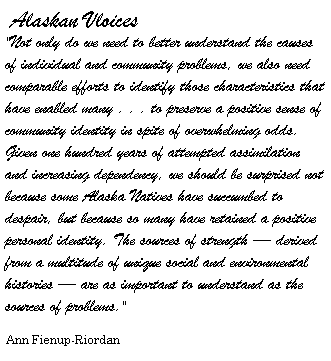| Recommendation 1. Congress should
establish policies and relationships supporting tribal
governments in Alaska beginning with the repeal of
disclaimers added to Indian legislation over the last ten
years that disavow Congress’ role in promoting the
federal relationship with Alaska Native tribes.
Discussion
The failure of the federal government
to clearly recognize Alaska Native tribes facilitates
assaults on fundamental tribal interests in the state and
federal courts by the State of Alaska and private
parties. The Secretary of the Interior partly resolved
this issue by publishing an Alaska Native tribal list on
October 21, 1993, clarifying that the entities listed are
traditional councils or Indian Reorganization Act
councils which the federal government deals with on a
government-to-government basis.
Congress, on the other hand, has
effectively removed itself from its role as a trustee of
the federal relationship with Alaska Native tribes by
including disclaimers in most recent Indian legislation.
These disclaimers state that nothing in the legislation
will either diminish or expand Alaska Native tribal
authority nor validate or invalidate any claim of
sovereign authority over lands and people. These
disclaimers are inconsistent with the federal
relationship with Alaska Native tribes. now that the
United States recognizes the tribes and any powers they
still possess.
Recommendation
2. The Secretary of the Interior
should withdraw Solicitors Opinion (Sol. Op. M-36,975)
and clarify the federal government’s position on the
jurisdictional status of Native lands in Alaska by
participating in pending federal court cases in support
of Alaska Native tribal claims to Indian Country.
Discussion
The Solicitor for the Department of the
Interior under the previous administration issued an
opinion concluding that Congress expressed an intent that
Native lands  retained under the terms of the Alaska Native
Claims Settlement Act do not constitute Indian Country.
Although the Solicitor acknowledges that restricted
townsite lots and allotments remain Indian Country for
federal jurisdictional purposes, it also concludes that
tribes do not exercise governmental authority over
practically any property the tribe might own or occupy. retained under the terms of the Alaska Native
Claims Settlement Act do not constitute Indian Country.
Although the Solicitor acknowledges that restricted
townsite lots and allotments remain Indian Country for
federal jurisdictional purposes, it also concludes that
tribes do not exercise governmental authority over
practically any property the tribe might own or occupy.
The opinion is untenable because it
supports an implicit extinguishment of tribal authority
contrary to established federal law. The federal courts
have already determined that Indian Country can exist in
Alaska and, contrary to the Solicitor’s Opinion,
that ANCSA did nor affect either the tribal or Indian
Country status of Indian lands in Alaska.
The Solicitor should support Alaska
Native tribal claims in federal courts that would
promote, rather than diminish, the federal relationship
with Alaska Natives.
Recommendation
3. Native communities should be
able to freely convey ownership and control of Native
lands between Native corporations, tribal governments,
individuals, and other Native institutions; and they must
be able to regulate these lands where competing uses
threaten tribal and subsistence interests regardless
which Native institution or individual holds title.
Discussion
Ownership and effective control by
Alaska Natives of lands on which they depend has been
markedly diminishing since statehood. Native people, as
evidenced by testimony offered to the Commission, want
the option of consolidating Native land ownership in ways
that are most protective of subsistence land values and
that expand jurisdiction over social and regulatory
matters, most notably alcohol importation and use and
domestic issues.
New ownership and jurisdictional
patterns would be enhanced by tribal land use plans and
co-management agreements with federal and state land use
and resource managers, and by formal agreements with
judicial and enforcement agencies.
At a minimum, the Secretary of the
Interior should take lands owned by tribes in Alaska into
trust when requested by a tribe to the extent such lands
have been transferred from an ANCSA village corporation
pursuant to a vote of the ANCSA village corporation
shareholders. Some tribes in Alaska are acquiring lands
from their ANCSA village corporations independent of the
process that led to the settlement of Alaska Native
aboriginal claims. For this reason, there is questionable
justification for treating tribes in Alaska any
differently from those elsewhere in the United States by
denying the protections of trust land status.
Recommendation
4. Tribal governments require a
financial base which the federal and state governments
should address through cooperative agreements and
legislation, such as to grant federal tax credits for
taxes paid to tribal governments and to provide equitable
state funding to residents regardless of the form of
government they elect to represent their communities.
Discussion
Tribes look to reduce their dependence
on federal grant funds by generating local tax revenues.
Current laws allow federal and state taxation within
tribal territory, making it difficult for tribal
communities to attract economic enterprises. The federal
government can address this situation and promote its
policy of self-determination by granting a tax credit for
taxes paid to tribal governments.
The State of Alaska currently
appropriates more funds to communities organized as state
municipal corporations than to villages governed by IRA
or Traditional Councils. Persons living in unincorporated
communities and Native communities organized under
federal charters are also state citizens but end up
receiving less state funding simply because of the form
of local government they have chosen. The State of Alaska
can address this inequity by funding communities on an
equal, per capita basis.
Recommendation
5. The State of Alaska should,
through Executive Order or legislative enactment or
resolution, recognize the existence of Native tribes in
Alaska to clear obstructions to successful implementation
of policies and programs affecting predominantly Native
areas of the state.
Discussion
Despite federal recognition, the State
of Alaska continues to attack the tribal status of Alaska
Natives in court decisions that conflict with federal
precedent and practice. At the same time, the State
consistently works to diminish any  authority and
jurisdiction that Alaska Native tribes might have. This
hostile position, while presumably protecting the
state’s authority, results not only in state court
decisions contrary to the self-governance goals of Alaska
Natives, but also in what are; more often than not,
adversarial regulatory and enforcement practices. authority and
jurisdiction that Alaska Native tribes might have. This
hostile position, while presumably protecting the
state’s authority, results not only in state court
decisions contrary to the self-governance goals of Alaska
Natives, but also in what are; more often than not,
adversarial regulatory and enforcement practices.
While it is not within the domain of
the State of Alaska to either establish or deny tribal
status, powers, and jurisdiction, a clear recognition of
the existence of Alaska Native tribes other than the
Metlakatla Community Council can have a multitude of
positive policy and program impacts. It will enable
officials and agencies of the State of Alaska to work
co-operatively with tribes in such critical areas as
Indian Child Welfare Act implementation, local law
enforcement and dispute resolution, and land and resource
management, among others.
 The Alaska Legislature. should, therefore, enact
legislation reversing the untenable policy on tribal
status reflected in Stevens Village v. Alaska Management
and. Planning in which the Alaska Supreme Court held that
there are no tribes in Alaska except for rare exceptions.
In addition, the Governor should, at a minimum, repeal
Administrative Order #125, in which is embedded the most
hostile formal position ever taken by an administration
against tribal governments in Alaska. The Alaska Legislature. should, therefore, enact
legislation reversing the untenable policy on tribal
status reflected in Stevens Village v. Alaska Management
and. Planning in which the Alaska Supreme Court held that
there are no tribes in Alaska except for rare exceptions.
In addition, the Governor should, at a minimum, repeal
Administrative Order #125, in which is embedded the most
hostile formal position ever taken by an administration
against tribal governments in Alaska.
LOOKING TO
SOURCES OF
STRENGTH
Prior to Vitus Bering’s 1741
arrival in North America, the vast expanse of land
anchoring the continent’s northwest reaches had been
home to Native peoples for countless centuries and
generations.
Tlingit and Haida Indians roamed the
forests and plied the waters of the southeastern coast.
The Eyak and other tribes found richness between the
Indians of the southeast and the Suqpiaq of the Alaska
Peninsula and the Southcentral region. The Aleut and
Koniag were established in the swirling mists and seas of
the Aleutian Archipelago and Kodiak. Occupying all of
southwest Alaska, its major rivers, the Bering Sea coast
and the island now called St. Lawrence were the Yupik
Eskimos. Inland were the Dene, the Athabascans, living in
the forests through which ran the Yukon River and, its
tributaries. And to the west and north of the Athabascans
were the Inupiaq, the brothers and sisters of the Yupik
people ,whose domain was a vast arctic expanse, in the
farthest reach of the hemisphere.
Collectively, the Native peoples knew
and revered the entirety of what was to become known as
Alaska. By the time of the arrival of Europeans, they had
named every major river and creek, every mountain and
valley. And, contrary to some current thinking, all of
Alaska was dotted with Native villages, most of which
have since passed into history.
Having developed an
intimate knowledge of the land and its resources, the
Native people located their villages in areas richest in
natural resources — by streams and rivers and along
the coastlines teeming with salmon and other marine life,
and near fertile hunting grounds. Here, over the course
of many thousands of years, the Alaska Native people
— ruled by their own spiritual beliefs, traditions,
customs, and environment — developed rich cultures
and intricate systems for community life and social
order.
Alaska Natives had
well-developed, time-tested political, social, and
economic systems tied intimately with nature and the
spiritual realm. To them, the temporal and the spiritual
intertwined. Because of this, they walked and lived in
both worlds. When a Tlingit or Athabascan walked into the
forest, or when a Yupik, Inupiaq, or Aleut pushed his
kayaq or umiaq into the sea, he entered not only the
hunting. grounds but the spiritual realm as well. Native
arts, songs, dances, feasts, and ceremonials reflected
this view of existence. Cultures and languages were
constructed around it.
 In a study that
helped. to lay the groundwork for the Commission’s
undertaking, anthropologist Ann Fienup-Riordan wrote that
despair is a natural side effect of 100 years of
attempted assimilation and increasing dependency. On the
other hand, she has pointed to the large number of Alaska
Natives who have retained a positive personal identity.
She has suggested that the sources of strength are as
important to understand as the sources of problems. In a study that
helped. to lay the groundwork for the Commission’s
undertaking, anthropologist Ann Fienup-Riordan wrote that
despair is a natural side effect of 100 years of
attempted assimilation and increasing dependency. On the
other hand, she has pointed to the large number of Alaska
Natives who have retained a positive personal identity.
She has suggested that the sources of strength are as
important to understand as the sources of problems.
If the Commission’s
message can be summarized, the point to be made is that
the strength truly does deserve attention. Read the
entire log of testimony submitted to the Alaska Natives
Commission, and at times you will be brought to tears.
But at other times, you will find yourself chuckling and
even laughing out loud at the tireless humor of people
who absolutely refuse to be beaten down and forgotten.
There is a lot of caring
and love sprinkled throughout the testimony the
Commission gathered. People who want more than anything
else to offer the very best opportunities to their
children find that without adequate water supplies, even
the most basic amenities seem like an impossible dream.
Parents are suffering because they know that the village
school their children attend ma y not compare to an urban
education. And yet, a look at the dropout statistics for
Natives in Alaska’s cities shows that urban schools
have their problems, too. The lack of employment, and
even the lack of hope of a future job, has turned many
Alaska Natives into less than well-functioning dependants
of government.
In incredibly depressing
statistics the scope of problems resulting from alcohol
abuse in the Native Community has been documented. Whole
families — and sometimes even entire villages —
have been nearly destroyed by this insidious stranger in
their midst who saps both body and spirit.
As the Commission
completes its report, however, we look to the future and
a people who have told us time after time that what they
want more than anything else is self-determination. The
testimony is not from people seeking an easy answer
brought in from outside. Alaska Natives have recognized
that no person and no agency will arrive on the scene to
"save" anyone. They know that their future is
bright only if they are self-reliant.
The tools for
Natives’ futures are the pages of our report. While
we hope that all of our recommendations are adopted as
soon as possible, we realize that what really matters is
the people’s strength of will. Among Alaska Natives,
strength of will is not an issue.
|
 in fluctuating
cycles of legislative, regulatory, and judicial
activity, alternatively surging and receding over the
years. Today, the Native subsistence rights that
Congress sought to protect in ANILCA are in greater
political jeopardy than at any time in the
nation’s history. They are now under concerted
political assault by powerful, organized interests
which compete with villages for limited public
resources that governments must allocate. The current
subsistence management impasse, which began with the
1989 Alaska Supreme Court ruling in McDowell v.
State of Alaska, should not be allowed to
continue.
in fluctuating
cycles of legislative, regulatory, and judicial
activity, alternatively surging and receding over the
years. Today, the Native subsistence rights that
Congress sought to protect in ANILCA are in greater
political jeopardy than at any time in the
nation’s history. They are now under concerted
political assault by powerful, organized interests
which compete with villages for limited public
resources that governments must allocate. The current
subsistence management impasse, which began with the
1989 Alaska Supreme Court ruling in McDowell v.
State of Alaska, should not be allowed to
continue. demonstrates the
unwillingness of the State of Alaska to protect
subsistence from the demands of sport, commercial, and
other uses of fish and game resources.
demonstrates the
unwillingness of the State of Alaska to protect
subsistence from the demands of sport, commercial, and
other uses of fish and game resources. From a strictly economic perspective, decreasing
federal and state budgets coupled with diminishing access
to and abundance of subsistence resources will assure
even less economic well-being than that which exists in
village Alaska today. Strategically, it behooves the
federal and state. governments to explore means for
empowering Alaska Natives in the areas of research and
wildlife and habitat management. This should include (1)
identification of institutional, regulatory, policy,
legal, and cultural barriers to Native participation in
wildlife research and management; (2) identification of
the major obstacles to development of co-management
regimes; (3) development of co-management programs with
funds. allocated toward development of the institutional
and cultural capacity for Alaska Natives to co-manage;
and (4) development of programs which increase Alaska
Native employment in the fields of wildlife research and
wildlife and habitat management.
From a strictly economic perspective, decreasing
federal and state budgets coupled with diminishing access
to and abundance of subsistence resources will assure
even less economic well-being than that which exists in
village Alaska today. Strategically, it behooves the
federal and state. governments to explore means for
empowering Alaska Natives in the areas of research and
wildlife and habitat management. This should include (1)
identification of institutional, regulatory, policy,
legal, and cultural barriers to Native participation in
wildlife research and management; (2) identification of
the major obstacles to development of co-management
regimes; (3) development of co-management programs with
funds. allocated toward development of the institutional
and cultural capacity for Alaska Natives to co-manage;
and (4) development of programs which increase Alaska
Native employment in the fields of wildlife research and
wildlife and habitat management. retained under the terms of the Alaska Native
Claims Settlement Act do not constitute Indian Country.
Although the Solicitor acknowledges that restricted
townsite lots and allotments remain Indian Country for
federal jurisdictional purposes, it also concludes that
tribes do not exercise governmental authority over
practically any property the tribe might own or occupy.
retained under the terms of the Alaska Native
Claims Settlement Act do not constitute Indian Country.
Although the Solicitor acknowledges that restricted
townsite lots and allotments remain Indian Country for
federal jurisdictional purposes, it also concludes that
tribes do not exercise governmental authority over
practically any property the tribe might own or occupy. authority and
jurisdiction that Alaska Native tribes might have. This
hostile position, while presumably protecting the
state’s authority, results not only in state court
decisions contrary to the self-governance goals of Alaska
Natives, but also in what are; more often than not,
adversarial regulatory and enforcement practices.
authority and
jurisdiction that Alaska Native tribes might have. This
hostile position, while presumably protecting the
state’s authority, results not only in state court
decisions contrary to the self-governance goals of Alaska
Natives, but also in what are; more often than not,
adversarial regulatory and enforcement practices. The Alaska Legislature. should, therefore, enact
legislation reversing the untenable policy on tribal
status reflected in Stevens Village v. Alaska Management
and. Planning in which the Alaska Supreme Court held that
there are no tribes in Alaska except for rare exceptions.
In addition, the Governor should, at a minimum, repeal
Administrative Order #125, in which is embedded the most
hostile formal position ever taken by an administration
against tribal governments in Alaska.
The Alaska Legislature. should, therefore, enact
legislation reversing the untenable policy on tribal
status reflected in Stevens Village v. Alaska Management
and. Planning in which the Alaska Supreme Court held that
there are no tribes in Alaska except for rare exceptions.
In addition, the Governor should, at a minimum, repeal
Administrative Order #125, in which is embedded the most
hostile formal position ever taken by an administration
against tribal governments in Alaska. In a study that
helped. to lay the groundwork for the Commission’s
undertaking, anthropologist Ann Fienup-Riordan wrote that
despair is a natural side effect of 100 years of
attempted assimilation and increasing dependency. On the
other hand, she has pointed to the large number of Alaska
Natives who have retained a positive personal identity.
She has suggested that the sources of strength are as
important to understand as the sources of problems.
In a study that
helped. to lay the groundwork for the Commission’s
undertaking, anthropologist Ann Fienup-Riordan wrote that
despair is a natural side effect of 100 years of
attempted assimilation and increasing dependency. On the
other hand, she has pointed to the large number of Alaska
Natives who have retained a positive personal identity.
She has suggested that the sources of strength are as
important to understand as the sources of problems.